Key takeaways
- Critical thinking in education fosters student ownership of learning, encouraging engagement through questioning and exploration.
- Different debate formats, like Fishbowl and Lincoln-Douglas, promote organized thinking and respect for opposing views, enhancing students’ reasoning skills.
- Designing debate activities that connect to real-world issues boosts student engagement and helps them develop critical thinking skills through analysis and reflection.
- Assessing critical thinking involves observing argument construction and the quality of questions asked, promoting deeper understanding and peer feedback.
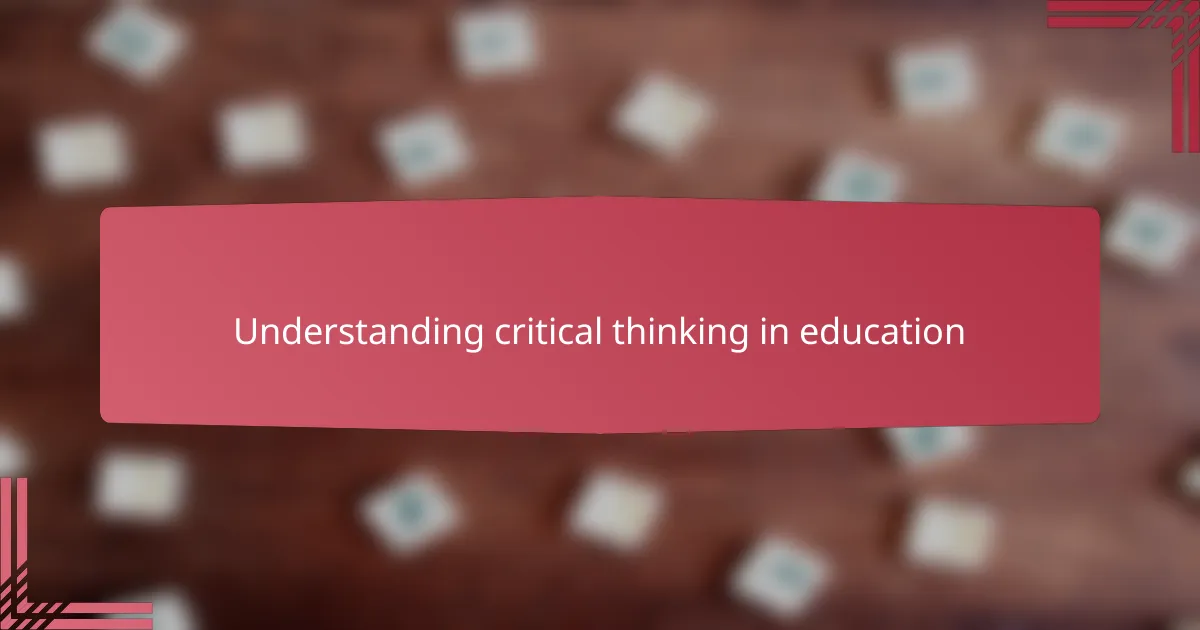
Understanding critical thinking in education
Critical thinking in education goes beyond memorizing facts; it’s about teaching students to analyze, evaluate, and create new understanding. I’ve seen firsthand how when students learn to question assumptions, their engagement deepens, and conversations become richer. Isn’t education supposed to spark curiosity rather than just fill empty vessels?
In my experience, critical thinking encourages students to take ownership of their learning. When I ask a challenging question, I notice a shift—hesitation turns into thoughtful exploration, sometimes even debate. This moment of grappling with ideas feels like the true heart of learning.
Why does this matter so much? Because critical thinking prepares students not just for tests, but for life. It teaches them resilience in facing complex issues and the confidence to voice their perspectives. Watching that transformation unfold in the classroom is what motivates me every day.
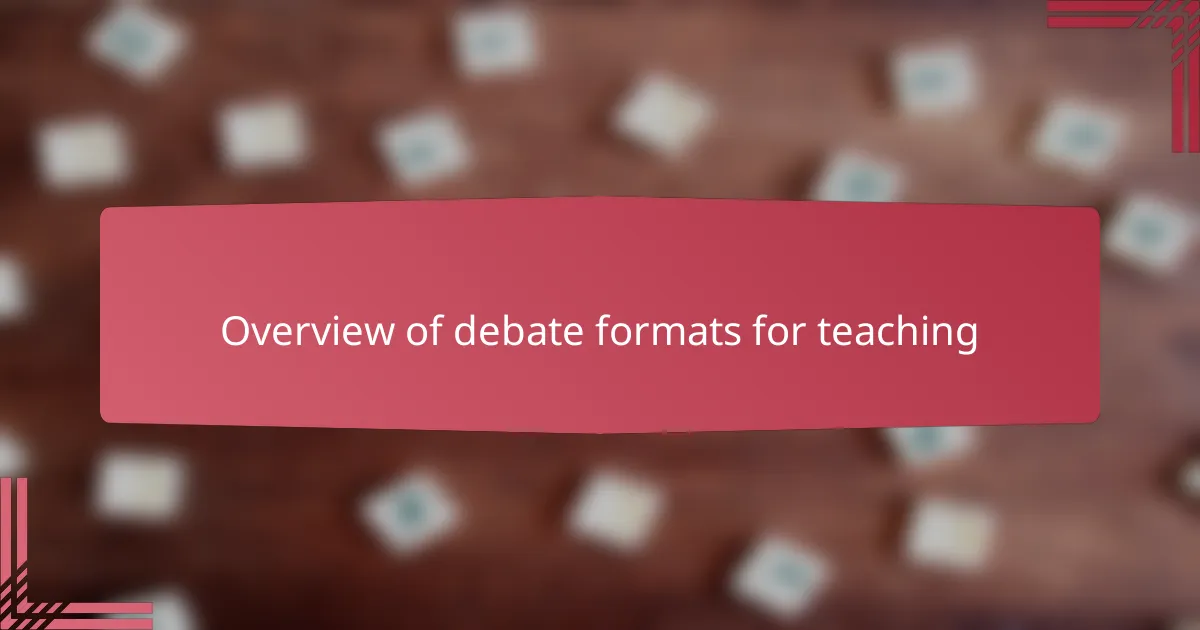
Overview of debate formats for teaching
When I started using different debate formats in my classroom, I quickly realized how the structure guided students’ thinking. Formats like Lincoln-Douglas or Parliamentary debates don’t just encourage students to argue; they teach them how to organize their thoughts clearly and listen to opposing views with respect. Have you noticed how a clear framework can turn chaotic opinions into meaningful dialogue?
One time, I introduced the Fishbowl format, where only a few students debate while others observe and later provide feedback. This not only kept everyone engaged but also helped quieter students warm up to sharing their ideas. Seeing that moment when a student shifts from hesitant to confident—that’s powerful evidence of critical thinking in action.
What’s truly fascinating is how each format offers unique challenges and benefits. Some emphasize quick thinking, others focus on evidence and logic, and some prioritize collaboration. I’ve found mixing these up keeps students curious and eager to improve their reasoning skills, making critical thinking feel less like a task and more like an adventure.
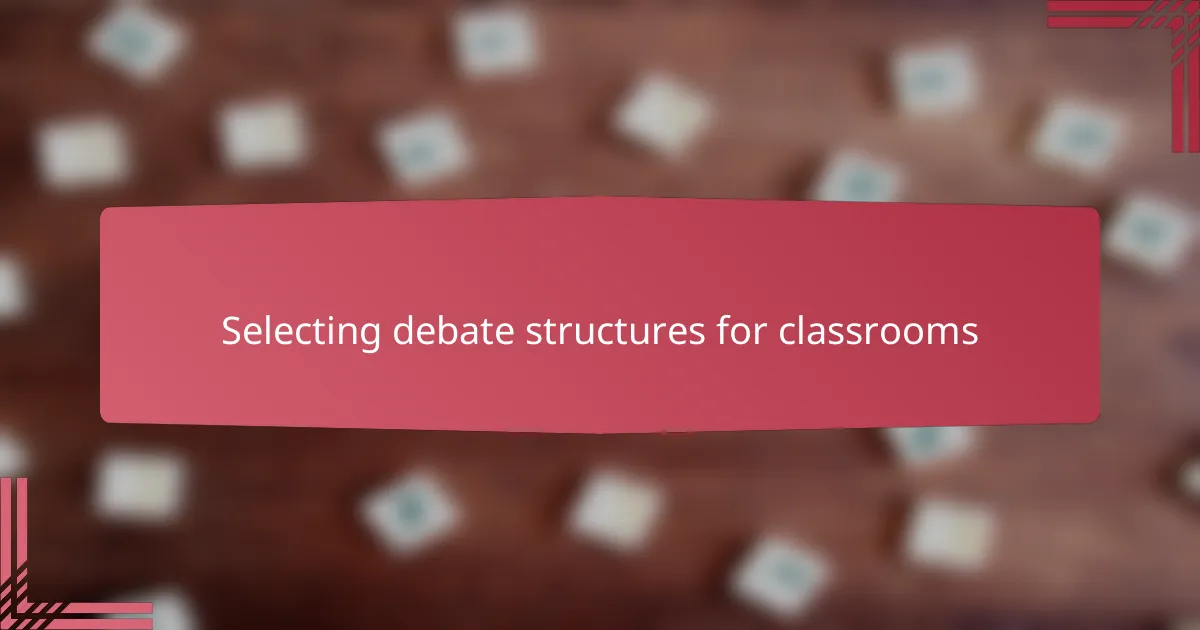
Selecting debate structures for classrooms
Choosing the right debate structure for my classroom often feels like picking the perfect tool for a job. I’ve noticed that some formats, like Lincoln-Douglas, suit students who thrive on deep, one-on-one argumentation, while Parliamentary debates energize those who love the back-and-forth of team collaboration. Have you ever seen a student’s confidence soar simply because the format matched their style of thinking?
There was this one time I switched to a “Great Debates” format — where students prepare arguments in small groups and then rotate roles as speakers, questioners, and judges. It revealed strengths I hadn’t expected, especially in quieter students who suddenly found their voice when their role changed. It’s remarkable how the right structure can unlock hidden potentials, don’t you think?
Selecting debate formats isn’t just about variety; it’s about matching the challenge to the learning goal. Sometimes I want students to focus strictly on evidence and logic, so I use formats that emphasize research and rebuttals. Other times, I prioritize spontaneous thinking and listening skills, opting for more dynamic, less scripted debates. Balancing these needs keeps the classroom buzzing with curiosity and growth.

Designing lessons with debate activities
Designing lessons with debate activities often begins with asking myself, what specific skills do I want my students to develop? For instance, when I crafted a lesson around the Oxford-style debate, I noticed students eagerly diving into research, sharpening their ability to find credible sources. That excitement to dig deeper felt like a direct result of giving debate a clear, purposeful role in their learning journey.
I like to sprinkle in moments where students can reflect on their own arguments, too. After a round of intense back-and-forth, I ask questions like, “What strategy worked best for you, and why?” These reflections create space for metacognition—thinking about their thinking—which, in my experience, strengthens their critical engagement far beyond the debate itself.
Sometimes, I build in unexpected twists, such as assigning students to argue a position opposite their belief. Watching the surprise on their faces as they grapple with opposing views is priceless. It’s in these moments of cognitive discomfort that I see the most growth, proving that well-designed debate activities don’t just fill heads with facts—they open minds.
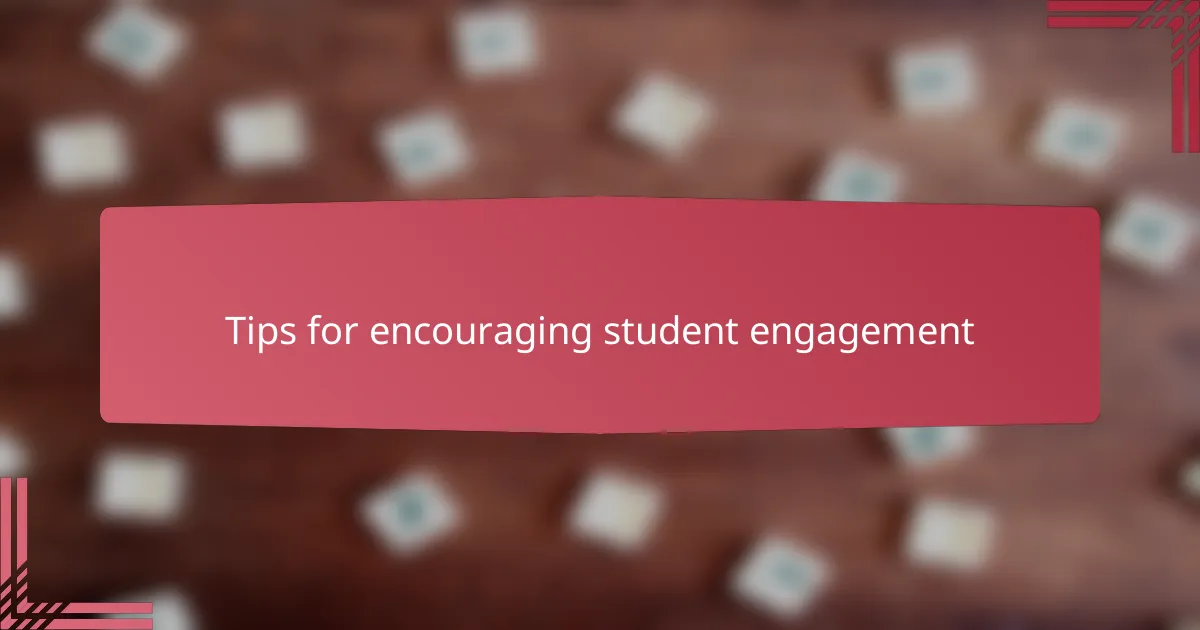
Tips for encouraging student engagement
Keeping students actively involved means mixing things up. From my experience, alternating between solo speeches and team debates breaks the monotony and keeps energy levels high. Have you noticed how variety not only sustains attention but also invites different kinds of thinking?
Another strategy I swear by is creating a safe space for risk-taking. When students know they won’t be ridiculed for an idea—even a flawed one—they’re much more willing to jump in. I’ve seen quiet students become some of the most passionate debaters simply because the classroom atmosphere felt supportive and encouraging.
Finally, I make sure to connect debate topics to real-world issues that matter to my students. When they see how their opinions can link to things they care about, like social justice or environmental concerns, their engagement spikes. Isn’t it amazing how relevance can transform a simple exercise into a genuine calling for action?
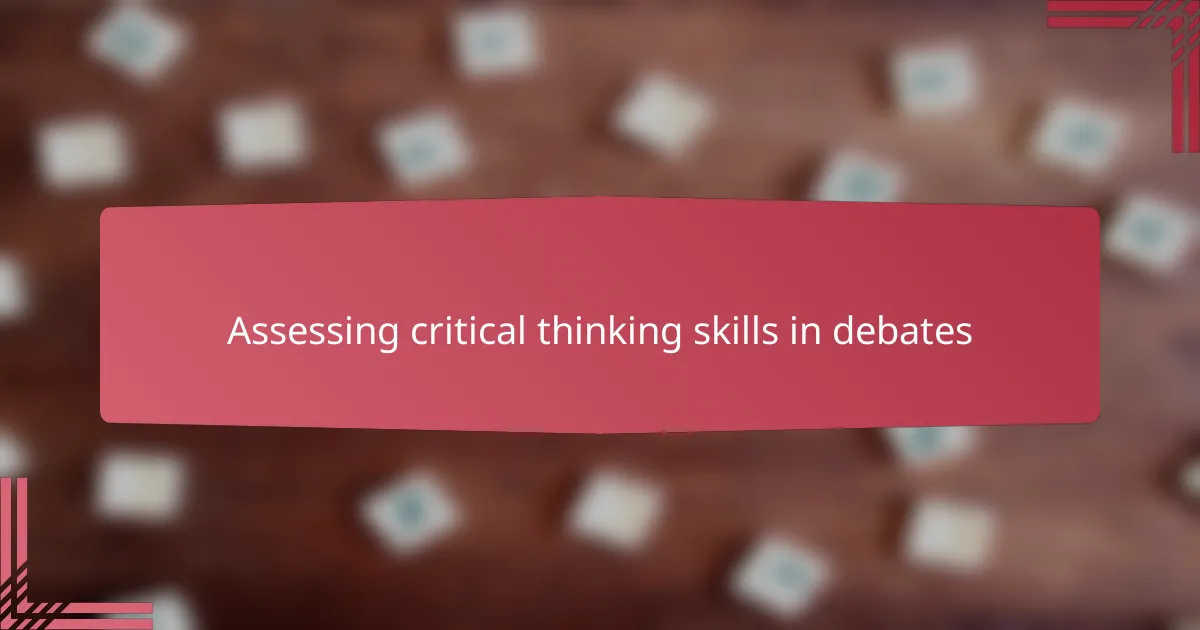
Assessing critical thinking skills in debates
Assessing critical thinking skills in debates isn’t just about ticking boxes on a rubric. From my experience, it requires listening closely to how students construct their arguments—do they rely on evidence, acknowledge counterpoints, and avoid logical fallacies? I once observed a student brilliantly turn a weak opposition claim into an opportunity for deeper analysis, and that moment told me more about their thinking skills than any test could.
I often wonder, how do we capture the nuance of critical thinking in a fast-paced debate setting? For me, it’s about paying attention to the quality of questions students ask during rebuttals. When a student challenges an assumption thoughtfully or probes underlying values, it reveals a more sophisticated level of reasoning that standard criteria might miss. That’s when I know critical thinking is truly unfolding.
Sometimes, I invite peers to provide feedback on both content and thought process. This peer assessment encourages students to critically evaluate arguments beyond their own, deepening their awareness of reasoning strategies. Watching them analyze each other’s thinking often leads to reflective discussions that surpass the original debate, making assessment a collaborative learning moment rather than just evaluation.
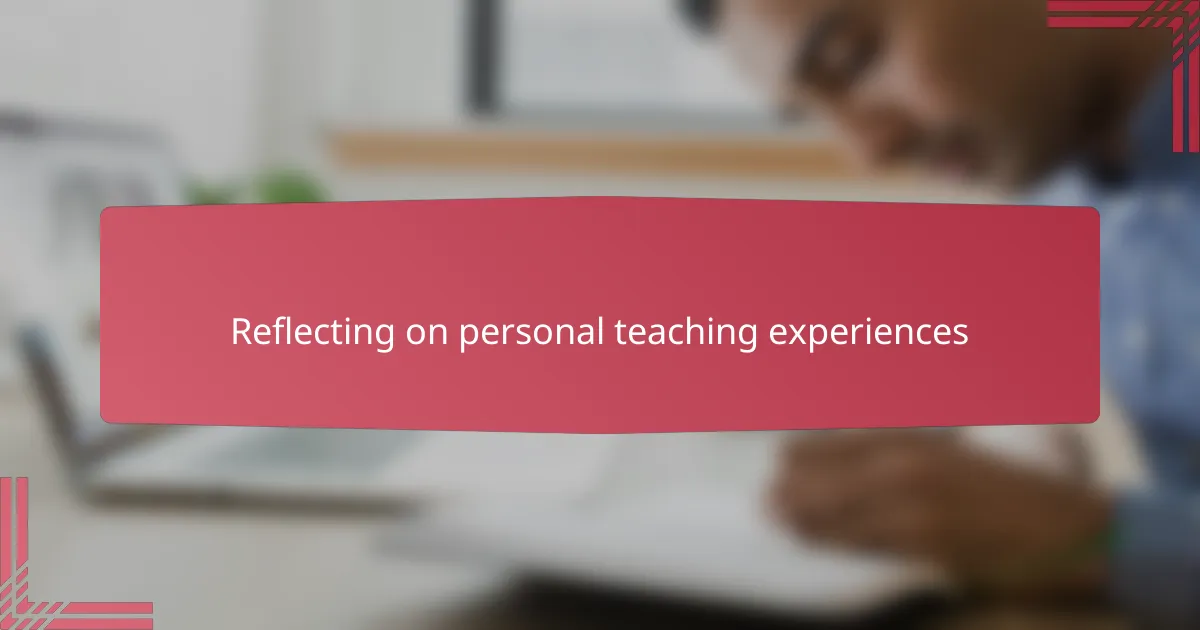
Reflecting on personal teaching experiences
Looking back on my early attempts to integrate debate into my teaching, I remember feeling both excited and uncertain. Would my students rise to the challenge of thinking critically, or would they cling to rehearsed opinions? That initial hesitation faded as I witnessed the spark in their eyes when they began questioning not only others but their own assumptions.
There was a turning point during a particularly heated debate when a usually quiet student interrupted with a thoughtful question that shifted the entire discussion. Moments like that remind me why reflecting on classroom experiences is so important—it keeps me attuned to those unexpected breakthroughs that no syllabus can predict.
Do I always get it right? Absolutely not. Each classroom dynamic teaches me something new about what works and what doesn’t. Embracing these lessons, even the failures, has deepened my understanding of how to nurture critical thinking authentically.